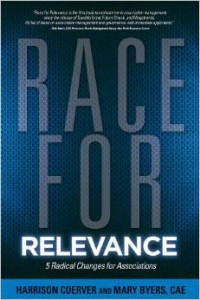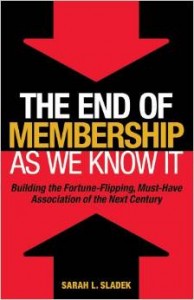 More and more associations are having conversations around relevance. Members are questioning how relevant their associations are to their businesses today and consequently, boards of directors are bringing those concerns to their meetings (after all, they are members, too, and feel a responsibility to deliver relevance to the overall association and its members).
More and more associations are having conversations around relevance. Members are questioning how relevant their associations are to their businesses today and consequently, boards of directors are bringing those concerns to their meetings (after all, they are members, too, and feel a responsibility to deliver relevance to the overall association and its members).
What does it mean to be relevant to your members and to businesses you want to recruit? Although they may not use the “R” word specifically, members and prospects alike consider these factors when evaluating your relevance:
- Alignment with Your Vision and Mission
- What is your greater vision and how do you plan to achieve it?
- Who do you serve and what do you for them?
- Who do you collaborate with to achieve your goals?
- Governance Model
- Does your board of directors reflect your membership base and the business community?
- What is the succession planning model to ensure that strong leadership is recruited and retained?
- What is the decision making process and how well does the leadership implement decisions?
- How adaptive is your board of directors to navigate change in the association and the community?
- Value Expectations
- How well do you address the issues facing businesses with positive outcomes?
- Do you offer programs and services that businesses care about and use?
- How well does your value proposition resonate with business leaders and owners?
- Positive Brand
- Is your leadership team seen as a driving force among members and policy decision makers?
- How well is your strategic direction and achievements communicated publicly?
- Do businesses see you as an effective leader, innovator, and conduit for success in the community?
- What are you known for in the community and how is your image perceived?
Leverage Trends and Adapt Your Model to be Relevant
Several trends present challenges and opportunities for associations. Recognizing these trends and finding effective and new opportunities to serve the business community will ensure that we are the indispensable entity in the communities where we serve.
- Time poverty means that everyone has less time to volunteer and to participate in date specific member benefits. Business owners and leaders are looking for ways to be more efficient with their time, resolve issues, and get more ‘bang for their buck.’ They are questioning how they spend their time and what value they receive for this precious investment. Associations must look for ways to educate, engage, and provide value to members that don’t require huge investments in time. Online delivery of education and access to resources 24/7/365 are no longer ‘nice to haves’ but essential.
- Generational differences can no longer be ignored. By 2020, the Y generation will represent more than 50% of the workforce and yet many association’s staff and board of directors do not reflect a representative body of this demographic group. Our associations will only be theirs if they have opportunities to ‘be at the table’ and make influential decisions. This generation of ‘digital natives’ value technology, innovation, globalization, and are willing to invest in causes that make real differences in their communities. We need to listen and be willing to evolve into a next-generation association that meets the needs of both the current and the emerging membership.
- Local and global competence is a requirement to be successful in business. Businesses large and small want to have a positive local presence and access to the global marketplace. They need a competent and adaptive workforce locally and need to market effectively on a global platform. Associations need to help businesses address the current and emerging talent shortage, training and retraining workers, and creating platforms and collaborations that provide global connections.
- Real-time business solutions are a must to deliver on value expectations from members and to attract new members. The roles for advocacy, economic development, and workforce development are more important than ever before and businesses need effective leaders who can make it happen. Small business owners are looking for solutions to their challenges and don’t feel that attending networking events are the answers to their dilemmas. Business owners need access to capital, expertise, skilled workers and specific connections to help them grow their businesses. Associations need to move from being ‘event coordinators’ to ‘solution providers’ to win the relevancy race.
Resources to Help You Stay Relevant
 We’ve made it our focus to help associations win the fight for relevance. Our spring and summer webinar series were created to help you redesign, refine, and
We’ve made it our focus to help associations win the fight for relevance. Our spring and summer webinar series were created to help you redesign, refine, and
- Kill the Sacred Zombie Cows — This webinar offers an objective process and tools to evaluate your programs and services. The worksheets and proposed criteria can help you identify which benefits to keep and disinvest from on an annual basis. The recording is available on our site.
- OH NO, Not Another Event — After analyzing the results from the Non-Dues Revenue Trends Survey conducted in April, we developed this webinar to highlight key themes and explore new and innovative ways to generate non-event dues revenue that deliver value to members. Frank J. Kenny and Glenn Shepard were co-presenters on the webinar and the recording is available on our site.
- The Fight for Relevance — This webinar scheduled for 6/20/12 explores insights from the Race for Relevance book and discusses specific strategies to employ to that will ensure you win this race.
- Next Generation Dues Trends — this webinar is scheduled for 7/18/12 and explores the emerging dues models from the book The End of Membership As We Know It. You’ll discover how associations are adapting their models to be more inclusive and taking advantage of technology, the global market and generational interests to offer memberships in a whole new way. Interestingly, you will recognize why the ‘fair share’ model based on employee count is on its way out!
I hope you realize that although this has been the ‘worst of times,’ it is also providing opportunities to become the ‘best of times.’ Where willingness is high to be relevant to current and future members, difficulty should not be to make the changes necessary.
